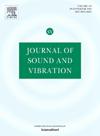Joint measurement of modulus of elasticity and Poisson’s ratio of concrete cubes by actuating special vibration modes: A novel baseline-free technique
IF 4.3
2区 工程技术
Q1 ACOUSTICS
引用次数: 0
Abstract
Elastic constants (e.g., modulus of elasticity and Poisson’s ratio) of concrete are vital material properties commonly measured by standard static tests (such as the destructive tests of cylinders or prisms), but the corresponding measurement results usually present a large dispersion. In addition, though extensively applied to measure modulus of elasticity, traditional dynamic methods cannot stably measure Poisson’s ratio of concrete, because of their sensitivity to material anisotropy and wall effects of concrete. To overcome these deficiencies, this paper, for the first time, presents a highly accurate method for directly measuring the elastic constants of concrete cubes with high stability using an improved baseline-free electromechanical impedance technique. With the ability of piezoelectric sensors to effectively capture a series of vibration modes of a concrete cube, unique modes can be identified, actuated, and employed for measurement. In this study, a series of numerical analyses were conducted firstly to (a) search anisotropy-insensitive vibration modes of a cube, (b) design corresponding sensor installation strategies for target modes extraction, (c) establish the quantitative evaluation methods, and (d) examine the reliability of the proposed method by considering anisotropy and wall effects. Then, experiments on concrete cubes were performed to show the high accuracy, stability, and reproducibility of the proposed method by comparing it with traditional standard static and dynamic methods.
通过驱动特殊振动模式联合测量混凝土立方体的弹性模量和泊松比:一种新的无基线技术
混凝土的弹性常数(如弹性模量和泊松比)是通常通过标准静态试验(如圆柱体或棱镜的破坏性试验)测量的重要材料特性,但相应的测量结果通常存在较大的色散。此外,传统的动力方法虽然广泛应用于测量弹性模量,但由于其对材料各向异性和混凝土墙体效应的敏感性,不能稳定地测量混凝土的泊松比。为了克服这些不足,本文首次提出了一种利用改进的无基线机电阻抗技术直接测量高稳定性混凝土立方体弹性常数的高精度方法。由于压电传感器能够有效地捕获混凝土立方体的一系列振动模式,因此可以识别、驱动和使用独特的模式进行测量。在本研究中,首先进行了一系列数值分析,(a)搜索立方体的各向异性不敏感振动模式,(b)设计相应的传感器安装策略以提取目标模式,(c)建立定量评价方法,(d)考虑各向异性和壁面效应,检验所提方法的可靠性。在混凝土立方体上进行了实验,并与传统的标准静态和动态方法进行了比较,结果表明该方法具有较高的准确性、稳定性和重复性。
本文章由计算机程序翻译,如有差异,请以英文原文为准。
求助全文
约1分钟内获得全文
求助全文
来源期刊

Journal of Sound and Vibration
工程技术-工程:机械
CiteScore
9.10
自引率
10.60%
发文量
551
审稿时长
69 days
期刊介绍:
The Journal of Sound and Vibration (JSV) is an independent journal devoted to the prompt publication of original papers, both theoretical and experimental, that provide new information on any aspect of sound or vibration. There is an emphasis on fundamental work that has potential for practical application.
JSV was founded and operates on the premise that the subject of sound and vibration requires a journal that publishes papers of a high technical standard across the various subdisciplines, thus facilitating awareness of techniques and discoveries in one area that may be applicable in others.
 求助内容:
求助内容: 应助结果提醒方式:
应助结果提醒方式:


